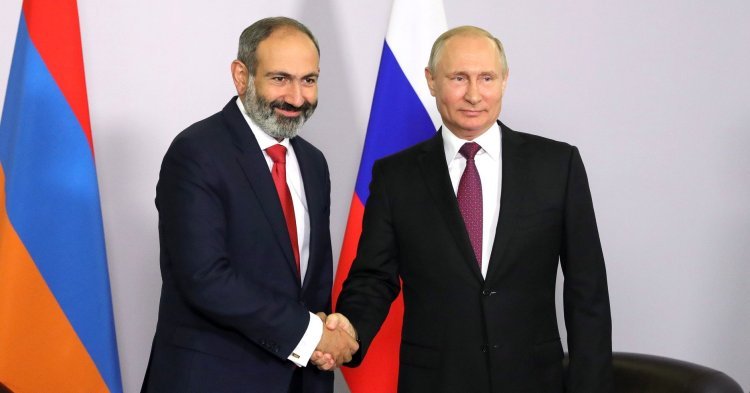Armenia’s EU accession could be a “question for the people”. This is what Tigran Avinyan, deputy Prime Minister of Armenia, said during an international event in Yerevan in 2019. This statement reveals that the new government of Armenia is more pro-European than previous administrations. As Avinyan pointed out in an interview with Euractiv.com on the sidelines of this event : “After the revolution, we have a completely different level of relationship […] The revolution affected those relations only positively because we share the same democratic values […] This new political team and this new political situation is completely in line with the EU’s views. I think we will see a lot of potential in growing our economic and political ties with the EU.”
However, the EU has not shown much interest in starting accession talks with the three other countries who would like to join the Bloc (Ukraine, Moldova, and Georgia). The Eastern Partnership, the pillar of the European Neighbourhood Policy in the East, has been designed precisely to create a framework without considering membership for the concerned countries.
Until now, Armenia’s cooperation with the EU has been based on the Comprehensive and Enhanced Partnership Agreement (CEPA) entered into force in mid-2018, as well as on the networks within the EaP.
How does Armenia collaborate with the EU in the Eastern Partnership ?
Armenia is a full member of the EaP, and takes part in many of the discussions between its members. It is also a member of a specific parliamentary assembly Euronest along with Ukraine, Moldova, Georgia, and Azerbaijan. Yerevan hosted the plenary assembly of Euronest in 2015.
According to the factsheet of EU-Armenia relations, edited by the EEAS, whose criteria are based on the 20 Deliverables for 2020, a work plan aiming at bringing tangible results in the four priorities of cooperation (economy, governance, networks and liberty of circulation). EU-Armenia relations have provided a number of tangible results. In the field of trade for instance, the EU is Armenia’s biggest export market and accounts for around 22% of Armenia’s total trade. Since 2009, more than €473 million have been allocated to Armenian companies and 25,000 enterprises have been supported. Concerning governance, the EU is supporting democratic reforms, such as the improvement of electoral legislation and the fight against corruption. Like in the other countries, civil society initiatives are strongly supported.
As for the fight against coronavirus, Armenia has received €92 million for its immediate and short-term needs, as part of the EU’s nearly €1 billion plan to support health sectors and economies in the Eastern Partnership.
Like Ukraine, Moldova, and Georgia, Armenia is trying to strengthen its bilateral relationship with the EU. As recently as January 2013, Yerevan was trying to negotiate an Association Agreement. However, in September 2013, President Serzh Sargsyan announced that his country would be joining the Russia-led Eurasian Union, often seen as a rival integration project to the EU, which led to the suspension of the negotiations with the EU. This development did not mean the end of the bilateral cooperation between Yerevan and Brussels, though. In 2017, negotiations to implement another agreement took place and led to the signature of the CEPA and its entry into force in 2018. As with the Association Agreements, the CEPA is also designed to bring Armenian law gradually closer to the EU acquis. However, it does not go as far as to establish an association between the EU and Armenia. The country’s involvement in the Eurasian Union is the main reason why it did not enter into a more comprehensive association with the Bloc.
The Eurasian Union vs. the European Union : can Armenia strike a balance ?
The treaty establishing the Eurasian Economic union was signed in May 2014 by the leaders of Russia, Belarus, and Kazakhstan, and came into force in January 2015. The treaty aiming for Armenia’s accession to the Eurasian Economic Union was signed in October 2014. Tigran Suren Sargsyan, a former Prime Minister of Armenia, has been Chairman of the board of the Eurasian Economic Commission since 2016.
The rationale behind Armenia’s membership to the Eurasian Union is geopolitically complex. Armenia is bordered by Turkey and Azerbaijan, two countries who have closed their borders with Armenia. The 1994 Nagorno-Karabagh conflict with Baku considerably restricted Armenia’s geopolitical options. Besides, Yerevan is militarily and energetically dependent on Russia. In May 2017, though, a paper published by the review Eurasian Geography and Economics came to the conclusion that the Eurasian Union “has not been able to contribute to Armenia’s economy – quite the contrary ; it has significantly slowed economic performance, adding more weight to the arguments that were utterly critical of Armenia’s decision to join Russia-led economic union”.
The 2018 Velvet Revolution, which brought Nikol Pashinyan to power as Armenia’s new Prime Minister, could have been seen as a powerful pro-European message. Given the reluctance of demonstrators to settle deeper into Russia’s sphere of influence, it seemed for a time that cooperation with Russia would be frozen. However, according to an article published by Eurasianet, “many in Armenia’s opposition-turned-government have muted their resistance to membership in the Russia-led bloc”. Last October, Yeveran even hosted a summit of the Eurasian Union. Arsen Kharatyan, a former journalist who joined Nikol Pashinyan’s new government as a foreign policy adviser said that the membership was “a reality, and a done deal, we’re not talking about pulling out the Union”.
Armenia is trying to create a geopolitical balance between the European Union and Russia, and wishes to collaborate with both, especially on trade matters. But it remains to be seen whether this strategy will work with the EU, who recalled in 2012 that “if Armenia were to join any customs union, this would not be compatible with concluding a bilateral Deep and Comprehensive Free Trade Agreement between the EU and Armenia because a customs union has a common external trade policy and an individual member country no longer has sovereign control over its external trade policies”.


Suivre les commentaires : |
|
